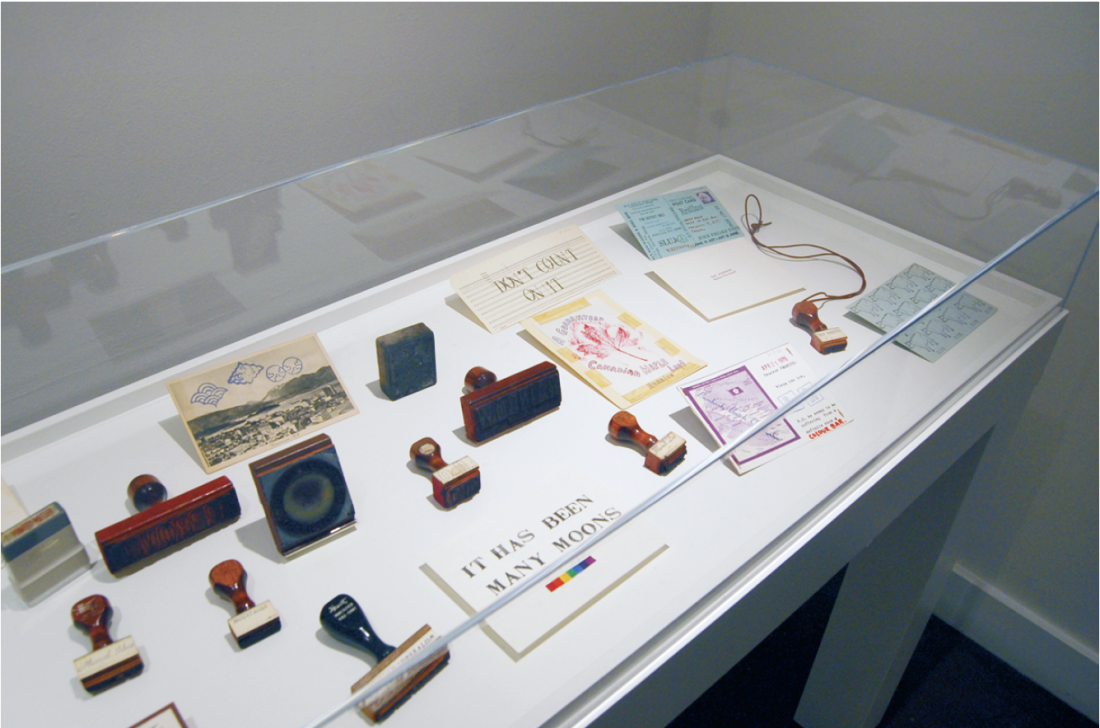“Make it Strange”
“Make It Strange” was a provocative little show in an unexpected venue. Installed in the Malaspina Printmakers Gallery, which is adjoined to a large printmaking studio, it was not about contemporary uses of traditional techniques such as lithography, serigraphy, etching or engraving. Rather, it proposed a way of looking at the wider idea of print culture. From posters and postcards to rubber stamps and government documents, the show examined how a few artists—Michael Drebert, Edgar Heap of Birds, Vanessa Kwan, Michael Morris and Vincent Trasov, and Lawrence Paul Yuxweluptun—have used or referenced printed materials to create images and convey ideas.

Michael Drebert, Nine O’Clock Gun, Ink on Paper, 96 x 69” 2010.
Small though the exhibition was, it spanned some four decades, from early correspondence art to present-day performance, installation and urban intervention. Selections from the archives of Michael Morris and Vincent Trasov, who created Image Bank in 1969, filled a vitrine at one end of the gallery. These tantalizing bits of mail art included found, original and altered postcards, letters and envelopes, and custom-made rubber stamps with which to create multiples of playfully contrived images, words and phrases. General Idea, Ray Johnson, Hank Bull and the Image Bank boys themselves were represented by an assortment of such Fluxus-inspired objects, all of them demonstrating a happy embrace of pun, provocation, image sharing and the unheroic everyday. The historic Image Bank works segued neatly into Vanessa Kwan’s contemporary appropriation of the postcard medium. In three related works, she examined the construction of urban identity through touristic images on commercial postcards. An example is Your Private Sky, 2005, in which Kwan subverted the boosterish act of urban self-definition by producing a set of photographic postcard views of New York, Toronto, Paris, Hong Kong, Tokyo and Sydney, each with punch-out panels of sky above their iconic architectural horizons. The possessor of the postcard set is encouraged to hold a punched-out, other-city image in front of a view of Vancouver, creating a new cityscape that conflates the two locations. It’s a clever idea that confounds clichéd notions of place and critiques, in particular, the persistent and benighted belief that Vancouver is “a world-class city.”
An Indian Act by Lawrence Paul Yuxweluptun comprises a video of two performances the artist undertook in England and Canada in 1997 and their aftermath—framed and editioned copies of the Canadian government’s June 1996 Indian Act pitted with shotgun holes. (Shotgun shells are also part of the edition.) The performance—Yuxweluptun’s act—consisted primarily of his taking aim at, and shooting, copies of the document. The lead shot has drilled neat holes into the front of this very explicit piece of printed matter, and blasted small eruptions out of the back. Among the artist’s angry assertions in this beautifully executed piece is the right of Aboriginal peoples to hunt and fish on lands stolen from them.

Michael Morris and Vincent Trasov, Selected rubber stamps and postcards from the Morris/Trasov Archive 1969-1972, Courtesy of the Morris and Helen Belkin Art Gallery, University of British Columbia.
Other works in the show included a photograph by Howard Ursuliak of a metal sign from Edgar Heap of Birds’s series Native Hosts. Installed on the campus of the University of British Columbia, this particular sign gives the provincial name in backwards capital letters, then reads “TODAY YOUR HOST IS MUSQUEAM.” As urban and academic intervention, it’s a strong reminder of the presence of First Peoples and their land claims.
Whether or not custom-made metal signage constitutes “printed material,” or even an aspect of “print culture,” is a nagging little question. Another work that perversely refused printed-matter status was Michael Drebert’s Nine O’Clock Gun, a large, hand-lettered, poster-like drawing mounted in the gallery’s front window. While acknowledging the presence of endlessly reproduced advertising posters within the urban environment, the artist apparently made a decision not to create this work in multiples. Was his idea to reclaim the act of one-off-ness in a world of mass media and massed messages?
When the Malaspina Printmakers Society was founded more than three decades ago, the idea was to share knowledge, defray studio costs and increase public awareness of the art forms practiced there. For many years, the gallery attached to the studio has been used to showcase members’ works and generate income for them and their programs and practices. “Make It Strange” is part of a programming shift that expands the gallery’s mandate from an outlet for what many see as a printmakers’ cooperative to a more wide-ranging artist-run centre. The show provoked thinking not only about the nature of print culture but also about how traditional printmaking techniques might be reinvigorated in the service of concept-driven art. ❚
“Make It Strange” was exhibited at the Malaspina Printmakers Gallery in Vancouver from January 22 to March 26, 2010.
Robin Laurence is a writer, curator and a Contributing Editor to Border Crossings from Vancouver.

